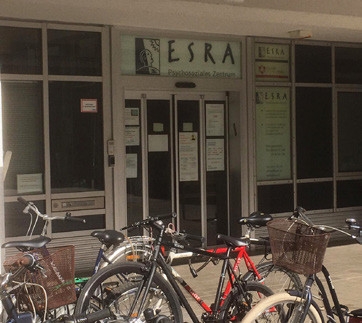The Vienna Connection
I always like visiting the special Jewish landmarks in all of the countries we visit, and the trip to Vienna promised to provide many such special and unique sites.
Towards the end of our Vienna trip, I did not expect to run into ESRA!
We had set out on a May morning of this year, to see the memorial for the Leopoldstadt Tempel. Finding it was no small task.
The Leopoldstadt Tempel was the second synagogue built in Vienna, officially opened in 1858.
During the years following The Revolution of 1848 (The Springtime of Nations), the Jews in Austria were granted civil rights and equality. In 1852, the Jewish community was finally recognized under the name Israelitische Kultusgemeinde (IKG). This brought increased immigration of Jews from the Crown Lands of the Monarchy to Vienna. In 1854, Emperor Franz Joseph I gave permission for the construction of a second synagogue.
And what could the ESRA connection be?
Back to the synagogue, the Leopoldstadt Tempel. It was designed by renowned architect Ludwig von Forster, and officially opened in 1858. It had a magnificent façade and because of social restrictions and confined space in the Tempelgasse, the architect had to resort to an architectural trick – to build a "free standing" temple. He designed the synagogue with a smaller building (annex) on either side, separated from the main building by an inner courtyard.
(This is where Vienna E.S.R.A is located today).
There was no distinctive architectural style for synagogues in the nineteenth century. Therefore, the Biblical description of the Temple in Jerusalem was often used as a guide. The huge three aisled structure was decorated in the style of Neoclassicism with Moorish, Arab and Assyrian touches.
The complex included the famous IKG Library – one of the largest and most valuable Jewish libraries in Europe. The Beit Hamidrash (1883-1938) was a liberal higher institute for Jewish Studies. It was one of the most respected training institutes for rabbis and Jewish religious leaders in Europe, modeled on the Jewish Theological Seminary in Breslau.
From 1858 to 1938, this was a place full of life. People lived, worked, prayed, studied, and celebrated there. The synagogue was destroyed and institutions broken up during and after the November Pogrom (Crystal Night) in 1938. This led to the persecution, disenfranchisement, looting, expulsion, deportation, and extermination of the Jewish population.
We were determined to find the synagogue memorial. We knew it consisted of four high poles on the Tempelgasse. After walking a bit with Google Maps, we came upon on a new Synagogue, in Tempelgasse. This was a new Tempelgasse (street) and a new synagogue on the Southern Bank of the Danube Canal which runs through the city. We had been searching on the South Side of the Canal, where the street names are the same as on the North Bank.
When we realized that we should cross the Canal, we were happy to run into restaurants. I chose "Piano," only relying on its name, that perhaps it was a pasta restaurant as those in Israel with a similar name. It was. We were the only customers, but a few minutes later, another gentleman came in. He heard us talking, identified the Hebrew, and told us he had been to Israel. I did not feel that this was just a chance encounter. After pleasantries, I asked him if he knew where the memorial for the Leopoldstadt Temple was. He answered that of course he knew. It was right around the corner – 2 rights. And as we exited, and turned right, a tall sign for E.S.R.A. loomed before me. I did not know what E.S.R.A. in German meant, but I knew I was in the right direction! What a welcome sign!
The Leopold Tempel Memorial was designed and created by the E.S.R.A Psychosocial Centre in cooperation with the architects Herbert Peter and Martin Kohlbauer. It was financed by the Leopoldstadt District Council and the Future Fund of the Republic of Austria.
The smaller annexes still survive. The left had the address of Tempelgasse 3 (where E.S.R.A is housed), while the right annex had the address of Ferdinandstrasse 23.
The complex commemorates the history of Vienna's Jewish congregation, and their desire to sustain the memory of a glorious Jewish past, thanks to E.S.R.A.












Comments